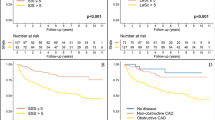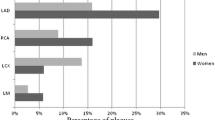Abstract
The recently introduced coronary artery disease reporting and data system (CAD-RADS) evaluated by computed tomography and based on stenosis severity, might not adequately reflect the complexity of CAD. We explored the relationship between CAD-RADS and the spatial distribution, burden, and complexity of lesions by invasive coronary angiography (ICA). Stable patients who underwent coronary computed tomography angiography (CCTA) and ICA comprised the study population. Patients were classified according to the CAD-RADS: 0, No plaque; 1, 1–24% stenosis; 2, 25–49%; 3, 50–69%; 4A, 70–99%; 4B, left main stenosis or 3-vessel obstructive disease; and 5, total occlusion. Based on ICA findings, we calculated the SYNTAX score and the CAD extension index. Ninety-one patients were included, with a mean age of 61.4 ± 10.5 years (74% male). We found significant relationships between CAD-RADS and both the SYNTAX score (p < 0.0001) and the CAD extension index (p < 0.0001), although the complexity of coronary anatomy differed among patients with CAD-RADS ≥ 4A. Among patients with CAD-RADS < 4, the mean segment involvement score (SIS) was 8.4 ± 4.0, 52% of them with a SIS > 5. Of the 30 patients with CAD-RADS 5, 9 (30%) affected distal segments or secondary branches, and 9 (30%) had concomitant severe non-extensive disease at ICA. Regarding the spatial distribution of the non-occluded most severe lesions, 27 (44%) comprised distal segments or secondary branches. In the present study including a high-risk population, we identified diverse coronary anatomy complexity scenarios and relevant differences in spatial distribution sharing the same CAD-RADS classification.



Similar content being viewed by others
References
Cury RC, Abbara S, Achenbach S et al (2016) CAD-RADS: Coronary Artery Disease - Reporting and Data System: An Expert Consensus Document of the Society of Cardiovascular Computed Tomography (SCCT), the American College of Radiology (ACR) and the North American Society for Cardiovascular Imaging (NASCI). Endorsed by the American College of Cardiology. J Am Coll Radiol 13(12 Pt A):1458–1466 e1459
Xie JX, Cury RC, Leipsic J (2018) The coronary artery disease–reporting and data system (CAD-RADS) prognostic and clinical implications associated with standardized coronary computed tomography angiography reporting. J Am Coll Cardiol 11:78–89
Foldyna B, Szilveszter B, Scholtz JE et al (2018) CAD-RADS - a new clinical decision support tool for coronary computed tomography angiography. Eur Radiol 28(4):1365–1372
Cury RC, Feuchtner GM, Batlle JC et al (2013) Triage of patients presenting with chest pain to the emergency department: implementation of coronary CT angiography in a large urban health care system. AJR Am J Roentgenol 200(1):57–65
Arbab-Zadeh A (2018) The challenge of effectively reporting coronary angiography results from computed tomography. JACC Cardiovasc Imaging 11(1):90–93
Leipsic J, Abbara S, Achenbach S et al (2014) SCCT guidelines for the interpretation and reporting of coronary CT angiography: a report of the Society of Cardiovascular Computed Tomography Guidelines Committee. J Cardiovasc Comput Tomogr 8(5):342–358
Halliburton SS, Abbara S, Chen MY et al (2011) SCCT guidelines on radiation dose and dose-optimization strategies in cardiovascular CT. J Cardiovasc Comput Tomogr 5(4):198–224
Girasis C, Garg S, Raber L et al (2011) SYNTAX score and Clinical SYNTAX score as predictors of very long-term clinical outcomes in patients undergoing percutaneous coronary interventions: a substudy of SIRolimus-eluting stent compared with pacliTAXel-eluting stent for coronary revascularization (SIRTAX) trial. Eur Heart J 32(24):3115–3127
Score S (2017) http://www.syntaxscorecom Accessed Mar 2017
van Rosendael AR, Shaw LJ, Xie JX et al (2019) Superior risk stratification with coronary computed tomography angiography using a comprehensive atherosclerotic risk score. JACC Cardiovasc Imaging. https://doi.org/10.1016/j.jcmg.2018.10.024
Hoebers LP, Elias J, van Dongen IM et al (2016) The impact of the location of a chronic total occlusion in a non-infarct-related artery on long-term mortality in ST-elevation myocardial infarction patients. EuroIntervention 12(4):423–430
Varnauskas E (1988) Twelve-year follow-up of survival in the randomized European Coronary Surgery Study. New Engl J Med 319(6):332–337
Elsman P, van ‘t Hof AWJ, Hoorntje JC et al (2006) Effect of coronary occlusion site on angiographic and clinical outcome in acute myocardial infarction patients treated with early coronary intervention. Am J Cardiol 97(8):1137–1141
Elhendy A, Mahoney DW, Khandheria BK et al (2002) Prognostic significance of the location of wall motion abnormalities during exercise echocardiography. J Am Coll Cardiol 40(9):1623–1629
Valgimigli M, Rodriguez-Granillo GA, Garcia-Garcia HM et al (2006) Distance from the ostium as an independent determinant of coronary plaque composition in vivo: an intravascular ultrasound study based radiofrequency data analysis in humans. Eur Heart J 27(6):655–663
Rodriguez-Granillo GA, Garcia-Garcia HM, Wentzel J et al (2006) Plaque composition and its relationship with acknowledged shear stress patterns in coronary arteries. J Am Coll Cardiol 47(4):884–885
Zheng G, Li Y, Takayama T, Nishida T et al (2016) The spatial distribution of plaque vulnerabilities in patients with acute myocardial infarction. PLoS ONE 11(3):e0152825
Kolodgie FD, Burke AP, Farb A et al (2001) The thin-cap fibroatheroma: a type of vulnerable plaque: the major precursor lesion to acute coronary syndromes. Curr Opin Cardiol 16(5):285–292
Toutouzas K, Karanasos A, Riga M et al (2012) Optical coherence tomography assessment of the spatial distribution of culprit ruptured plaques and thin-cap fibroatheromas in acute coronary syndrome. EuroIntervention 8(4):477–485
Kume T, Okura H, Yamada R et al (2009) Frequency and spatial distribution of thin-cap fibroatheroma assessed by 3-vessel intravascular ultrasound and optical coherence tomography: an ex vivo validation and an initial in vivo feasibility study. Circ J 73(6):1086–1091
Rodriguez-Granillo GA, Garcia-Garcia HM, Valgimigli M et al (2006) Global characterization of coronary plaque rupture phenotype using three-vessel intravascular ultrasound radiofrequency data analysis. Eur Heart J 27(16):1921–1927
Blaha MJ, Budoff MJ, Tota-Maharaj R et al (2016) Improving the cac score by addition of regional measures of calcium distribution: multi-ethnic study of atherosclerosis. JACC Cardiovasc Imaging 9(12):1407–1416
Hadamitzky M, Achenbach S, Al-Mallah M et al (2013) Optimized prognostic score for coronary computed tomographic angiography: results from the CONFIRM registry (COronary CT Angiography EvaluatioN For Clinical Outcomes: an InteRnational Multicenter Registry). J Am Coll Cardiol 62(5):468–476
Ostrom MP, Gopal A, Ahmadi N et al (2008) Mortality incidence and the severity of coronary atherosclerosis assessed by computed tomography angiography. J Am Coll Cardiol 52(16):1335–1343
Min JK, Dunning A, Lin FY et al (2011) Age- and sex-related differences in all-cause mortality risk based on coronary computed tomography angiography findings results from the International Multicenter CONFIRM (Coronary CT Angiography Evaluation for Clinical Outcomes: An International Multicenter Registry) of 23,854 patients without known coronary artery disease. J Am Coll Cardiol 58(8):849–860
Maddox TM, Stanislawski MA, Grunwald GK et al (2014) Nonobstructive coronary artery disease and risk of myocardial infarction. JAMA 312(17):1754–1763
Chaitman BR, Rosen AD, Williams DO et al (1997) Myocardial infarction and cardiac mortality in the Bypass Angioplasty Revascularization Investigation (BARI) randomized trial. Circulation 96(7):2162–2170
Rodriguez-Granillo GA, Carrascosa P, Bruining N et al (2016) Defining the non-vulnerable and vulnerable patients with computed tomography coronary angiography: evaluation of atherosclerotic plaque burden and composition. Eur Heart J Cardiovasc Imaging 17(5):481–491
Bittencourt MS, Hulten E, Ghoshhajra B et al (2014) Prognostic value of nonobstructive and obstructive coronary artery disease detected by coronary computed tomography angiography to identify cardiovascular events. Circ Cardiovasc Imaging 7(2):282–291
Arbab-Zadeh A, Fuster V (2016) The risk continuum of atherosclerosis and its implications for defining CHD by coronary angiography. J Am Coll Cardiol 68(22):2467–2478
Motoyama S, Ito H, Sarai M et al (2015) Plaque characterization by coronary computed tomography angiography and the likelihood of acute coronary events in mid-term follow-up. J Am Coll Cardiol 66(4):337–346
Author information
Authors and Affiliations
Corresponding author
Ethics declarations
Conflict of interest
We declare that Dr. Patricia Carrascosa is consultant of GE Healthcare. There are no competing interests related to the manuscript for any of the other authors.
Ethical approval
The protocol was approved by the institutional ethics committee and all studies have been performed in accordance with the ethical standards as laid down in the 1975 Declaration of Helsinki and its later amendments.
Informed consent
Informed consent was obtained from all individual participants included in the study.
Additional information
Publisher's Note
Springer Nature remains neutral with regard to jurisdictional claims in published maps and institutional affiliations.
Rights and permissions
About this article
Cite this article
Rodriguez-Granillo, G.A., Carrascosa, P., Goldsmit, A. et al. Invasive coronary angiography findings across the CAD-RADS classification spectrum. Int J Cardiovasc Imaging 35, 1955–1961 (2019). https://doi.org/10.1007/s10554-019-01654-1
Received:
Accepted:
Published:
Issue Date:
DOI: https://doi.org/10.1007/s10554-019-01654-1




